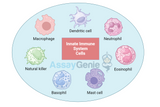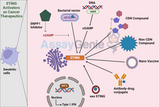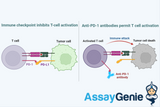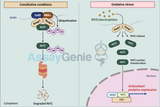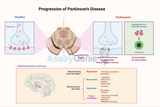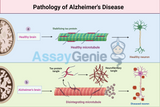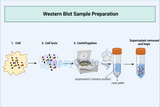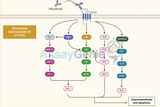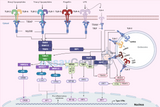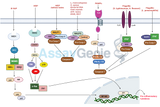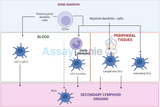Blog
Innate Immune System Cells: An In-depth Overview
The innate immune system is the first line of defense against pathogens, providing a rapid response to infections. This system comprises various cell types, each with specialized roles in detecting and eliminating invaders. In this article, we delve into the intricate world of innate immune system cells, exploring their functions, types, and contributions to the body's defense mechanisms. Introduction to the Innate Immune System The innate immune system is a crucial component of the body's defense, capable of immediate action upon encountering pathogens. Unlike the adaptive immune system, which requires time to develop a specific response, the innate immune system provides a gene
…
28th Mar 2024
The Rat Effectively Models Signature Cytokines of T Helper Cells
Understanding the immune system's intricacies requires models that accurately reflect its complexity. The rat, as a model organism, plays a crucial role in immunological research, particularly in the study of T helper (Th) cells and their signature cytokines. This article explores how rats model the signature cytokines of Th cells, shedding light on their contributions to immunological research. Introduction to T Helper Cells and Their Cytokines T helper cells, a subset of T cells, are pivotal in the immune system's adaptive response. They assist other cells in the immune system through the secretion of cytokines, signaling molecules that modulate the immune response. These cell
…
26th Mar 2024
STING Activators As Cancer Therapeutics
The STING (Stimulator of Interferon Genes) pathway plays a pivotal role in the innate immune system's response to cancerous cells and DNA viruses. Exploiting this pathway through STING activators presents a promising avenue for cancer therapeutics. This article delves into the mechanism of action of STING activators, their therapeutic potential, challenges in their development, and the latest advancements in the field. Understanding the STING Pathway The Biological Role of STING The STING pathway is integral to the innate immune response, detecting cytosolic DNA to trigger the production of type I interferons and other cytokines. This response is crucial for the immune syst
…
15th Feb 2024
Targeting Immune Checkpoints as Cancer Therapy
The advent of immune checkpoint targeting marks a significant milestone in the oncological field, offering a beacon of hope for patients battling cancer. This innovative approach leverages the body's immune system to recognize and combat cancer cells, a method that stands in stark contrast to traditional therapies. This article delves deep into the essence of immune checkpoint therapy, exploring its mechanisms, benefits, challenges, and the horizon it promises for future cancer treatments. Introduction to Immune Checkpoints Immune checkpoints are critical regulators of the immune system's response to various cells, including cancer cells. They are designed to prevent the immune s
…
13th Feb 2024
NRF2 Signaling: A Keystone in Inflammation and Disease Management
Nuclear Factor Erythroid 2–Related Factor 2 (NRF2) orchestrates a principal defense mechanism against oxidative stress and plays a pivotal role in inflammation and disease pathogenesis. This article explores the mechanism of NRF2 signaling, its intricate relationship with inflammation, its implications in various diseases, and the therapeutic potential of NRF2 modulation. Understanding NRF2 Signaling Basic Mechanism of Action NRF2 is a transcription factor that, upon activation, migrates to the nucleus to bind to Antioxidant Response Elements (ARE) in the DNA, promoting the expression of genes involved in antioxidant defense, detoxification, and cellular homeostasis.
…
12th Feb 2024
Understanding Parkinson's Disease: Insights and Innovations
Parkinson's disease (PD) is a progressive neurological disorder that predominantly affects the motor system, leading to a wide range of symptoms including tremors, rigidity, bradykinesia (slowness of movement), and postural instability. This article delves into the pathophysiology, symptoms, diagnosis, and treatment options for Parkinson's disease, providing a comprehensive understanding of this complex condition. Understanding Parkinson's Disease Pathophysiology Parkinson's disease is characterized by the degeneration of dopamine-producing neurons in the substantia nigra, a region of the brain that plays a critical role in regulating movement. The decline in dopamine leve
…
8th Feb 2024
Alzheimer's Disease: A Comprehensive Insight
Alzheimer's disease stands as a formidable challenge in the realm of neurological disorders, characterized by its progressive nature and profound impact on cognitive functions. This article delves deeper into the facets of Alzheimer's disease, exploring its causes, mechanisms, clinical manifestations, and current therapeutic strategies, enriched with current scientific insights. Etiology and Risk Factors Genetic Factors The genetic landscape of Alzheimer's disease is complex, with both hereditary (familial AD) and sporadic forms. Key genes implicated in its pathogenesis include the amyloid precursor protein (APP), presenilin-1 (PSEN1), and presenilin-2 (PSEN2). Mutations i
…
7th Feb 2024
Guide to Western Blot Sample Preparation
Western blotting remains a pivotal technique in the molecular biosciences for the detection, quantification, and analysis of proteins. Its utility spans numerous fields, including immunology, developmental biology, and disease diagnostics. A critical determinant of success in Western blotting is the quality of sample preparation. This guide delves into the nuances of preparing samples for Western blot analysis, ensuring that researchers can achieve reproducible and meaningful results. Key Points to be Discussed Introduction to Western Blotting Sample Collection and Storage Protein Quantification Sample Buffer Preparation and Use Sample Denaturation and Loading Troubleshooting C
…
6th Feb 2024
Deciphering B Cell Cancers With a Rituximab Biosimilar
The fight against B cell cancers, a challenging spectrum of hematologic malignancies, has entered a new era with the introduction of rituximab biosimilars. These biosimilars promise to extend the revolutionary benefits of rituximab, a cornerstone in the treatment of diseases like non-Hodgkin lymphoma (NHL) and chronic lymphocytic leukemia (CLL), to a broader patient population. This detailed exploration covers the complex nature of B cell cancers, the therapeutic mechanism of rituximab, and the significant potential of its biosimilars. Introduction B cell cancers represent a diverse group of malignancies that require nuanced therapeutic approaches. The advent of biosimilar thera
…
5th Feb 2024
Toll-Like Receptor Signaling Pathways: A Key to Innate Immunity
In the intricate landscape of the immune system, toll-like receptors (TLRs) play a fundamental role in the first line of defense against pathogens. These receptors, essential components of the innate immune response, are adept at recognizing specific microbial patterns, initiating signaling pathways that lead to the activation of immune responses. This article delves into the toll-like receptor signaling pathways, underscoring their importance in immunology and potential therapeutic applications. Understanding Toll-Like Receptors Toll-like receptors are a class of proteins that play a critical role in the immune system by detecting microbial infections and activating the immune r
…
5th Feb 2024
IL-9 Signaling and Its Impact on Immune Cell Regulation
Interleukin-9 (IL-9) plays a critical role in the immune system, influencing a variety of biological functions across different immune cell types. This article provides an in-depth look at the signaling mechanisms of IL-9 and its widespread effects on immune regulation, specifically focusing on its impact on T cells, mast cells, basophils, B cells, and regulatory T cells (Tregs). IL-9 Signaling Pathway Overview of IL-9 Receptor Activation IL-9 interacts with the IL-9 receptor (IL-9R), composed of the IL-9Rα chain and the common gamma chain (γc), initiating the JAK-STAT signaling cascade. This activation promotes the transcription of genes that regulate cell prol
…
1st Feb 2024
Nod-Like Receptor Signaling Pathway: A Keystone in Innate Immunity
The innate immune system, a primary line of defense against pathogens, comprises various cellular and molecular mechanisms. Among these, the Nod-like Receptor (NLR) signaling pathways play a critical role. They are central to the immune response, acting as intracellular sensors of pathogen-associated molecular patterns (PAMPs) and danger-associated molecular patterns (DAMPs). This article delves into the basic components of NLR signaling pathways, their key steps, roles in development, and implications in disease. Basic Components of Nod-Like Receptor Signaling Pathways: Nod-like receptors (NLRs) belong to the pattern recognition receptor (PRR) family and are primarily located in
…
30th Jan 2024
Dendritic Cells: Tracing the Developmental Lineage Pathway
Dendritic cells (DCs) are pivotal in the immune system, orchestrating innate and adaptive immune responses. Understanding their developmental lineage pathway is crucial in immunology, particularly in the context of cancer and infection responses. Introduction to Dendritic Cells Dendritic cells are unique antigen-presenting cells (APCs) that play a crucial role in the immune system. They are known for their ability to capture and present antigens, thereby bridging innate and adaptive immunity. DCs are heterogeneous, comprising various subsets with distinct phenotypes and functions. This diversity is a result of their complex developmental lineage. Origin and Early Development
…
5th Jan 2024

